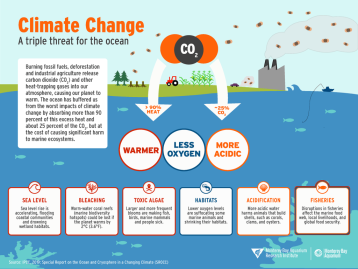Planetary boundary 4: Ocean Acidification
Introduction
A large part of the carbon dioxide (CO2) emissions released by human activities is absorbed by the oceans, just like other natural carbon reservoirs such as forests, which are referred to as “carbon sinks”. ". This CO2 retention capacity plays a fundamental role in climate regulation. The very significant increase in CO2 of anthropogenic origin results in the acidification of the oceans and is at the origin of a very significant loss of marine biodiversity due to the degradation of coral reefs.

Issues related to ocean acidification
A quarter of CO2 is absorbed by the ocean through dissolution or photosynthesis. The dissolved CO2 is transformed into carbonic acid and releases H + ions responsible for the acidification of the oceans. The drop in pH affects the ability of phytoplankton to grow and renew itself. Phytoplankton is the primary producer of oxygen on Earth. It is at the base of the food chain for all living things in the oceans. Its disappearance therefore leads to a great loss of marine biodiversity.
Like plankton, coral has difficulty developing in an acidic environment. Their degradation also leads to the decline of a very rich biodiversity.
The reefs also guarantee coastal human communities many services (protection of the coast against storms, underwater tourism and recreation, food supply, water purification, etc.) and contribute to local development. Conversely, other environmental impacts resulting from human activities on the coast (overfishing, land pollution, urban development along the coasts, etc.) combine with the acidification of the oceans and the rise in sea level. sea to weaken coral reefs.
The disappearance of coral reefs in favor of more banal ecosystems dominated by algae is a marker of the vitality of the oceans and their ability to continue to function as carbon sinks.
https://ree.developpement-durable.gouv.fr/
Stakes for 2100
The future state of the oceans will depend on how much CO2 is emitted into the atmosphere in the coming decades. According to the IPCC, 4 scenarios are possible depending on the evolution profile of greenhouse gas (GHG) emissions.
The most optimistic RCP2.6 trajectory predicts a sharp reduction in GHG emissions with a peak before 2050 (this trajectory is compatible with a maximum warming of 2 ° C by 2100). The most pessimistic RCP8.5 scenario predicts an increase in emissions at the current rate leading to a probable warming of 4 ° C in 2100.
In the case of RCP2.6, the surface water temperature and pH could increase by 0.71 ° and 0.07 pH units, respectively. In the case of RCP8.5, they would increase by 2.73 ° and 0.33 pH units (an increase in acidity of 170% compared to 1850).
https://ree.developpement-durable.gouv.fr/themes/defis-environnementaux/limites-planetaires/les-9-limites-ecologiques-de-la-planete/article/acidification-des-oceans
Situation in France
The issue of ocean acidification is important for France because the country has more than 11 million km2 of exclusive maritime economic zones and represents about 20% of the atolls and 10% of all the reefs on the planet over a linear distance of more than 5000 km.
In the Mediterranean, over the period 2007-2015, the temperature of surface water increased by 0.7 ° C. The pH decreased by 0.003 units per year, an increase in acidity of almost 7%, which corresponds to one of the highest acidification rates recorded to date (Kapsenberg et al., 2017 )
Impacts of ocean acidification on biodiversity
The decrease in pH has a strong impact on marine biodiversity. The health and ecology of species (birth rate, reproduction, species behavior, etc.) depend on the quality of the water. According to the ANR Gigassat project, the decrease in pH would alter the ability of oysters to resist disease and the reproductive cycle of fish.
Acidification is also one of the causes of the disappearance of coral reefs (29% decrease in the living coral cover of the stations monitored in the French overseas territories).